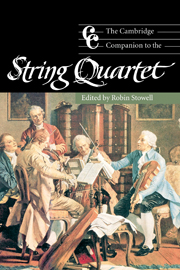4 - The concert explosion and the age of recording
from Part II - Celebrated ensembles
Published online by Cambridge University Press: 28 September 2011
Summary
In the last years of the nineteenth century, the prototype of the modern string quartet ensemble emerged: democratic, virtuosic, well rehearsed and no longer tied to one locality but willing to travel in search of work. It was necessary to embrace the work ethic because concert fees had to be split four ways: a front-rank violinist such as Adolf Busch would receive as much for playing one concerto as his entire quartet would earn for playing the equivalent of three concertos in an evening. Summer festivals were virtually unknown in 1900 and artists lived for the whole year on what they could make in the winter season. Only a fortunate few ensembles had wealthy sponsors; hence the members of many quartets supported themselves partly by teaching or by orchestral playing – and it was common for the string principals of an orchestra to appear as a quartet, whether they matched well or not.
The almost obsessive perfectionism that would mark twentieth-century ensembles was still unknown; but before long, it was beginning to take shape in response to the demands of the new music. As with most developments in the history of string playing, technical progress was patchy and sporadic. However, two countries in particular, Bohemia and Hungary, consistently led the way in advancing standards. The emergence of the gramophone record, the proliferation of chamber music societies and the ease of modern transport, which made touring by professional quartets a viable proposition, all played their parts in these developments; and the two World Wars acted as watersheds for the introduction of new generations of ensembles. By midway through the century, festivals were beginning to spring up all over the world in the summer months; and the idea of having a resident quartet in an educational institution was catching on.
- Type
- Chapter
- Information
- The Cambridge Companion to the String Quartet , pp. 60 - 94Publisher: Cambridge University PressPrint publication year: 2003
- 1
- Cited by

